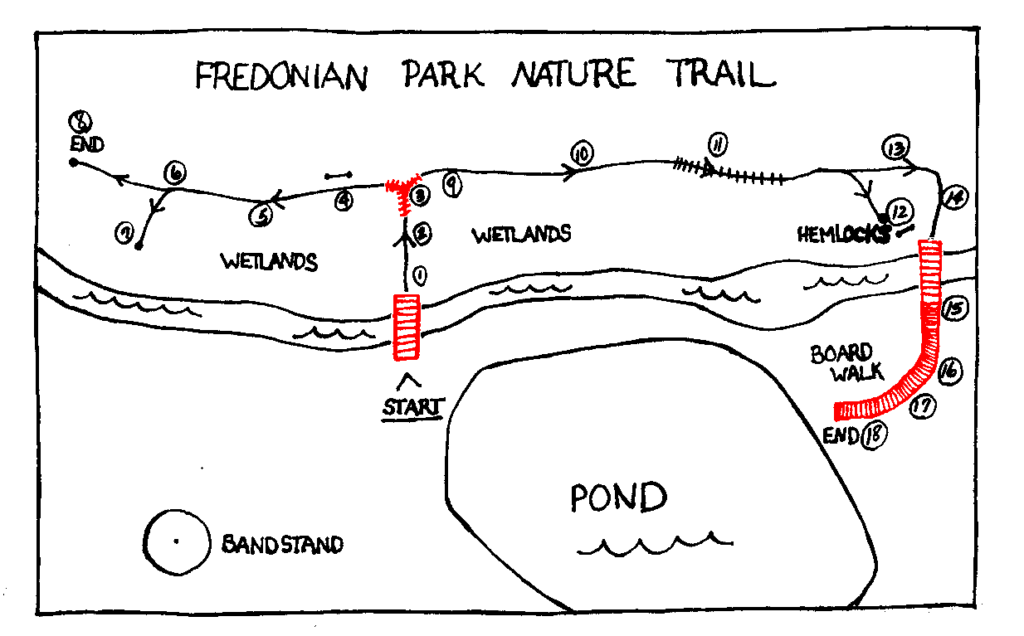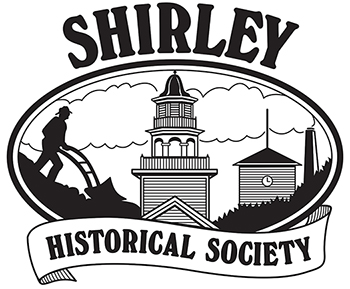Here is a glimpse at what the Fredonian Nature Center looked like when it was first dedicated on September 9, 1979. Many of the things mentioned have disappeared, but many are still there. A map at the end shows where the numbered natural points of interest were (and many times still are!) located.
A field trip was made in Summer, 2000, to see what items are still present, and what items are missing. Plants which still exist appear in green. Those which are missing appear in red. As necessary, notes of clarification appear under an item’s text. The posts which used to mark the items are missing for the most part. The field trip didn’t cover the area of the former boardwalk.
Last revision: November 10, 2005
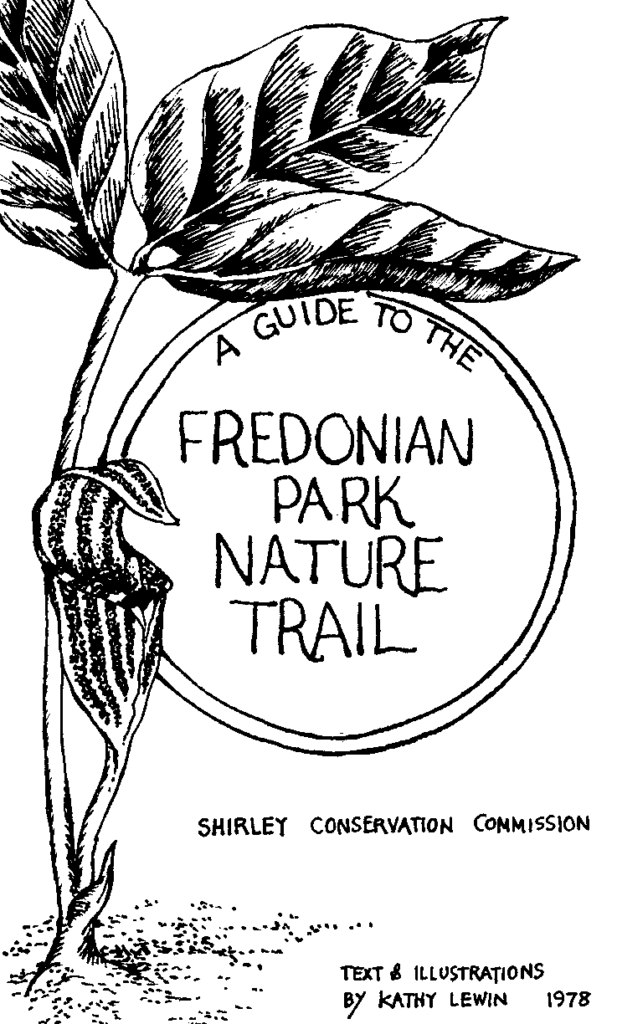
Welcome to the Fredonian Park Nature Trail.
This trail is short and it is comfortable walking for most everyone. Along the trail are numbered marker posts that correspond to the entries in this booklet. The trail begins at the bridge and as they continue, the trail forks to the left and to the right. If you go to the left after the third stake, the numbered entries continue in the normal sequence with four, five, etc. If you take a right turn after post three, jump to entry nine in this booklet.
Take Care
When walking the nature trail, please wear shoes and stay on the marked path. Though many bags of trash have been picked up, there is always more. Glass, rusty pieces of metal and other sharp-edged objects may be hidden beneath your feet. Please, take care.
Should you encounter any trash along your walk, please, pick it up and carry it out to a trash barrel. Leave the trail as you would like to see others leave it for you; clean and safe.
In several places along the nature trail there are briars and thorny plants to watch for. Poison ivy is the last culprit to be aware of. To those who have an allergy to this plant, an affected area will produce an itchy red rash that may last as long as a week. This plant grows along the boardwalk. If you remain on the marked path you should not encounter any poison ivy.
Observe
This guide identifies many of the plants along the trail but as you walk ask yourself questions. Why does this plant grow here and with this other plant? Notice the plant’s color, odor, texture and form. Watch for birds and animals that eat parts of plants. Look at all parts of the plant; leaves, flowers, stems, roots, fruits and nuts. Each part has a special purpose in the life of the plant and they can help you identify the plant later.Number One
Look for large, broad oak leaves. Did you find them? Swamp oak grows as a hardy tree or shrub as it is here. It grows where soils are very moist. In cities, swamp oak is planted as an ornamental tree because it is resistant to smoke and gas pollution. Its acorns are small and the caps have a very rough texture hence its other name bur oak.
Christmas green! Search for a small evergreen shrub of mountain laurel on the lower right slope of the trail. Laurel is used in many Christmas wreaths because its shiny leaves stay deep green throughout winter. In June it blossoms with starry pink-white flowers. Mountain laurel is the state flower of both Connecticut and Pennsylvania. It’s pretty but it’s also poisonous to cattle and sheep that mistakingly graze on it.
A petite flower is at your feet. It’s a Canadian Mayflower or one leaf. In May its shiny single leaves yield to a tiny white cluster of flowers.
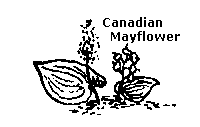

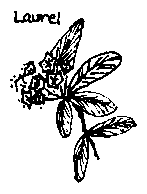
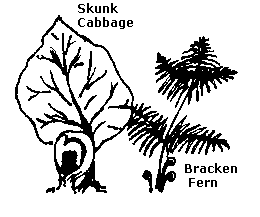
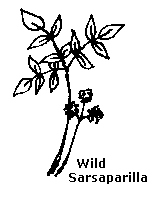
Number Two
The earliest New England bloomer is rarely noticed, skunk cabbage. It has a purple-brown flower made up of two parts. A hood or spathe biding the actual flower or spadix. Skunk cabbage may bloom as early as February or March. The most recognized characteristic of the skunk cabbage is its offensive odor when its broad leaves are crushed. The skunk cabbage is to the right of the trail in the swamp.
Look for five fronds extending from a brown stem to identify the bracken fern; they are to your left. Bracken fern is found all over the United States and because it dies soon after the chill of autumn creeps in, it is an indicator of the first frost.
The bright, green ground cover here is wild sarsaparilla. Its stem divides into three leaves of five leaflets. When it blossoms in May, three round clusters of white flowers appear on a short stem. The flowers turn to clusters of dark, blue berries. Wild sarsaparilla roots were used to produce a tea by the Indians of New England.
Number Three
Live-forever sedum looks like it may have escaped from an old English rock garden. This dusty green plant is an easily transplanted, fast growing succulent. In summer, grey-green flowers appear clustered atop the dense growth of erect stems. Ahead is a thick growth of jewel weed. Jewel weed is a brittle plant given its name because of the silvery luster of its leaves when submerged in water. Bright orange speckled flowers bloom in midsummer and by August turn to seedpods that explode when touched. For this reason, it is also called touch-me-not.
Here the trail forks. If you go to the left, the trail will continue with numbered entries four through eight taking you to the end. Then you will need to retrace your steps back to this point before continuing with nine through eighteen on the trail now to your right. If you decide to go to the right on the trail, jump to entry nine in this booklet.
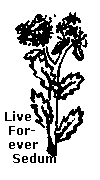
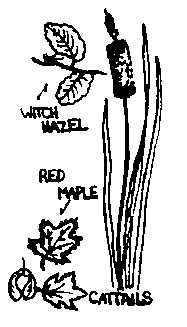
Number Four
Did your grandmother use witch hazel alcohol? It was made by distilling the wood of the witch hazel tree that now forms a canopy above you. Witch hazel leaves have broad rounded teeth and the leaves attach alternately to the twigs. Small spidery yellow flowers bloom in fall and witch hazel nuts appear in late summer.
[Note: The witch hazel canopy is at a rise in the trail.]
Look out to the swamp and what do you see? Most people easily recognize cattails by the brown cat blossom perched amongst the slender leaves. The base of cattail stems can be cut for a crunchy cucumber-like snack.
[Note: The cattails are hard to see through the shrubs, but it is possible.]
Number Five
A small child could fit beneath that strong formation of roots. This is a red maple tree. The roots have bound stones, sticks and even a dog’s bone. The red maple has small leaves with tiny teeth that turn fiery red in autumn. Tiny bright red flowers are a sign of spring when they bloom in late March.
Wild grapevines have begun to entangle this red maple both above and below. Follow the vines about your feet to the ones stretching through the limbs above your head.
Number Six
The enormous tree to your right is a black cherry; easily identified by the scaly black bark. It grows many other places along the nature trail so try again to recognize it as you walk. Black cherry wood is often used in cabinetmaking. Though the fruit of the black cherry can be made into jelly and jam, the wilted leaves, if eaten by livestock, act as a poison.
Marker post number seven is downhill to your left.

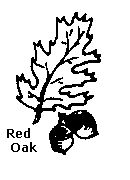
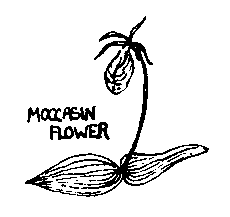
Number Seven
Notice how this red oak is growing. The end in the swamp is alive yet the fallen trunk at the end near you is dead. Looking closely you can see that the oak has sharp toothed, deep-cut leaves and its bark often has a red tint. This fast grower is often used as an excellent fire wood. Red oak is often planted as a fine ornamental shade tree.
Near the post, search for sets of two leaves growing flat on the ground. This is lady slipper or moccasin flower belonging to the orchid family. Being an uncommon wild flower, there is good reason for some states such as New York to prohibit legal picking or injuring this plant. The moccasin flower is the state flower of Minnesota.
Number Eight
The red oak, this one having five grand straight trunks, has always had many commercial uses. Its wood is strong and durable, giving it uses such as railroad ties, fine furniture and heavy construction material.
Maple leaf viburnum is the low shrub that grows along the trail. Its hairy leaves resemble those of a maple tree. In spring a flat cluster of white flowers blooms only to later yield to a cluster of green seeds. The Indians once used maple leaf viburnum for the shafts of their arrows.
If you back track to marker post three, you may continue the trail by going to the left.
Number Nine
The trail continues by going between two noble sentries. The mammoth tree to your left is a white oak. Know it by its deeply cut, round-toothed leaves and very coarse bark. White oak wood is strong and heavy and it makes an excellent fuel for wood burning stoves. It’s a slowly growing tree but given time, it may grow to be 600 years old. Acorns fall in October to be eaten by squirrels but they were once used by Indians that baked them and ground them to make a source of food. The tree with its stronghold to the right is a red maple. Red maples also called swamp maples, thrive in very moist soils. Pass between these two trees to continue on the trail.
[Note: The white oak is now a large fallen snag with no bark. The red maple is a large 8-foot-tall stump in an advanced state of decay. A large black cherry has fallen across the trail just past these two trees. It is still growing.]
Ahead is a patch of false Solomon’s seal. Its arching stem holds a cluster of white flowers in May and dark red berries in September. When compared to greater Solomon’s seal, it is found that greater Solomon’s seal has bell-shaped flowers and opposite leaves rather than star-like flowers and alternate leaves.
To the right are tall green ferns. These are cinnamon ferns growing to three feet in height. Spring sends up their fiddle heads covered with cinnamon colored hair. Fall turns to mature fronds to sticks covered with dusty brown spores, hence the name cinnamon fern.
Number Ten
Here are the giants. A row of five enormous trees each are hundreds of years old. These trees have been seen before on the nature trail; there are three white oaks, a red oak and a red maple. Can you recognize them?
[Note: Two red oaks and a white oak (the largest of the three) appear to be all that’s left.]


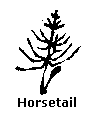

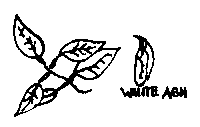
Number Eleven
Living fossils. A very primitive plant, horsetails have frequently been found fossilized in rock from the Carboniferous period, 250 million years ago. the time when coal was laid in the earth. Horsetails grow about ten inches in height and have bushy segmented stems and branches.
[Note: The horsetails are growing under the touch-me-not.]
The grass-like plants that are growing in the moist soil are sedges. They differ from grasses in that their stems are triangular not round. Try to roll a sedge between your fingers and then compare it to a grass.
Many white ash trees grow here. They are tall slender trees with rough, grey bark. Their leaves have five to seven leaflets. White ash is another good fuel wood and a fine wood commercially because of its whiteness and straightness of grain.
Number Twelve
These tall evergreen trees are eastern hemlocks. Their short striped needles and tiny cones litter the ground. The branched limbs make a dense cover overhead, allowing no light to filter through, thus discouraging smaller plant life from growing. If you sit quietly here you may see a couple of kingfishers picking a meal from the creek. Squirrels enjoy the cone on the hemlock tree and may play in the branches above.
The yellow birch is the only tree that can tolerate the acid soil produced by the hemlock tree. It has shiny gold-grey bark and small toothed leaves. The twigs, when broken, release a wintergreen aroma that is a common trait of all birch trees. When used as a fuel, it produces a good bed of coals and campers find that the thin peelings of bark are excellent tinder for the campfire.
Number Thirteen
Look uphill to see two favorite trees almost hugging. They appear to grow from the roots. Do you know them? They are white oak and black cherry.
[Note: A red oak and a black cherry appear at this location now.]
The trail has very sandy banks now and it is easy to see many exposed roots of the surrounding trees. Erosion has caused this soil condition. Erosion is a slow force that wears away soil and carves rocks and it is caused by wind and water. Many of these trees may someday topple down because they’ll have no soil left to hold onto.
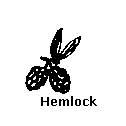

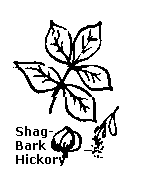
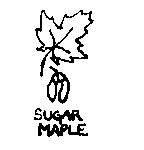
Number Fourteen
Ahead is a shag-bark hickory tree, one of several along the trail. Its loose stripping bark gives it its name and makes it easy to identify. It has compound leaves like the white ash having five or seven leaflets. It yields oily hickory nuts that are sold in supermarkets Hickory has strong wood that is used in baseball bats and tool handles. Search for a tree that has green bark striped vertically with white It has broad leaves the shape of a goose’s footprint. It is the goosefoot maple or striped maple. Its trunk is slender and its leafy branches bend gently. Striped maple is grown as an ornamental tree that gives deep shade.
Number Fifteen
Sugar maple, having broad, simple-toothed leaves, is widely known in New England. Its smooth grey trunk can be seen burdened with sap buckets every February and March. The sap of the sugar maple is two and a half per cent sugar, therefore, it takes 40 gallons to make only one gallon of syrup.
Jack-in-the-pulpits are a common wetlands wildflower blooming with a purple to green flower in early summer. (See the cover) A hood covers the “jack” and the whole flower grows beneath an umbrella of three broad leaves. As the flower dies, the hood falls away to expose a mass of red seeds.
Number Sixteen
The fern that enjoys this wet soil is the sensitive fern. It’s bright green with simple fronds. It is a hardy grower and it will take root in a wide range of soils. It wilts rapidly when it is picked and for this reason, is called sensitive fern.
Beyond the sensitive fern is a truly aquatic plant. Pickerel weed has delicate blue flowers during the summer months and when it grows in large patches in ponds and marshes, the blossoms form a blue carpet. It has thick glossy heart-shaped leaves and grows to nearly three feet tall. The seeds are eaten by wild ducks in autumn.
Number Seventeen
Poison ivy grows lushly here. It’s a hardy plant whose viny branches will climb trees or creep along the ground. Don’t touch it because of the itchy rash you may get. Learn to know poison ivy by its notched leaves in groups of three.
Here there are several willow trees growing well because they enjoy the wet soil. They are related to the weeping willow but differ in that their leaves are several inches shorter. The seeds in fall have long silky silvery hairs that grow from spring times catkins. These willows have many branches that are covered with bunches of yellow vertical shoots. These shoots have the slender leaves willows are known for.
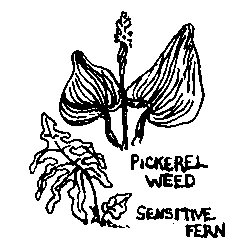

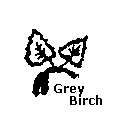
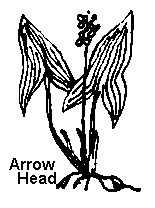
Number Eighteen
A small stand of grey birch grows here in the swamp. It thrives in the direct sunshine. Its bark is white and flecked with black. Grey birch leaves are small hearts with many tiny teeth growing alternately from black branches.
Arrow heads or duck potato grow throughout this area. Their arrow shaped leaves give away their identity. They have white, three-petaled flowers in early summer. Enjoying the shallows, you may see small egg shaped tubers growing from the base of the plant. These tubers were eaten by the Algonquin Indians after they had been roasted. These tubers are also eaten by wild ducks.
Thanks to Wendy Woods, Andy Lewin, Karl Lucander and especially Stan Kotlow and Miss Shirley Griffin.
NATURE TRAIL PROJECT FUNDED BY GRANT
Conservation Commission 77-78
Shirley L. Griffin
Sophie Jurga
William Scudder
Ernest Michaud
Hermann Field
Edward Swieca
1977-1978
– FUNDED BY A GRANT –
FROM THE
MIDDLESEX CONSERVATION DISTRICT
BRIDGES AND BOARDWALK
FROM A GRANT
– CETA –
NASHUA RIVER WATERSHED ASSOCIATION
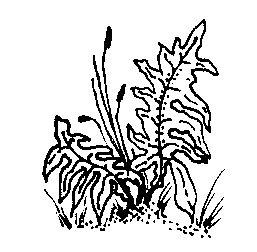
Shirley Conservation Commission
In the map below, the parts of the trail which are now missing are painted in red. The natural points of interest numbered above and below are currently being surveyed to see what is present and what has disappeared.
